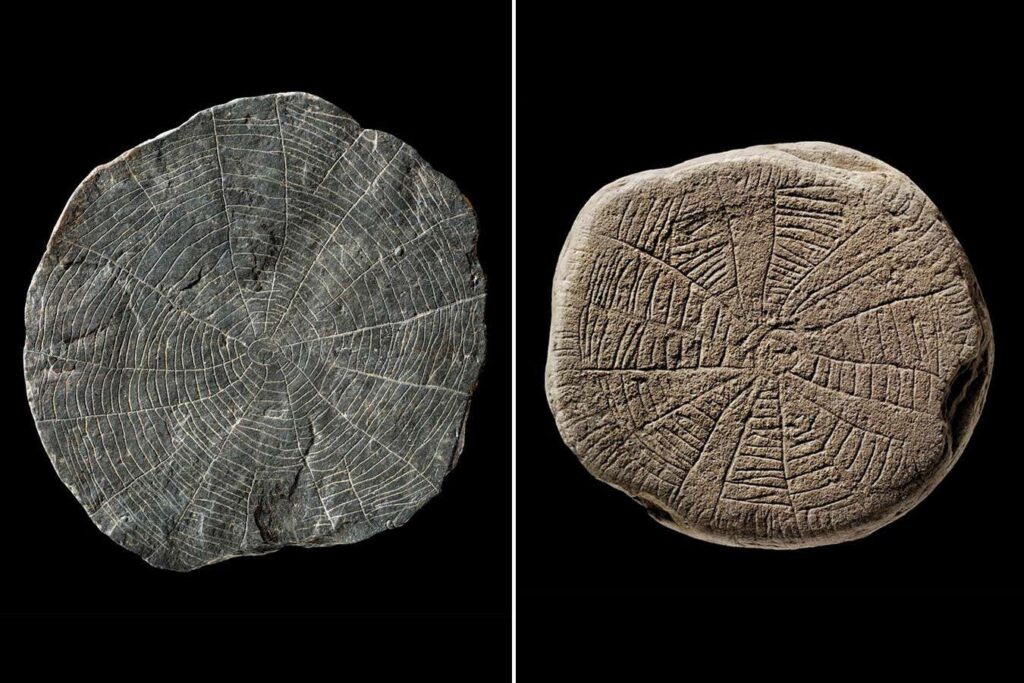Stone plaques with sun motifs found on Bornholm island, Denmark
Antiquity Publications/John Lee, National Museum of Denmark
Hundreds of mysterious engraved “sun stones” unearthed in Denmark may have been ceremonially buried because a volcanic eruption in about 2900 BC made the sun disappear.
A total of 614 stone plaques and fragments of plaques engraved with decorative motifs of the sun or plants have been unearthed in recent years at the Vasagård West archaeological site on the Danish island of Bornholm. They were found in a layer that dates to some 4900 years ago, when Neolithic people were farming the area and building enclosures encircled by earthworks of banks and ditches.
Most of the carved sun stones were found in the ditches around these enclosures and they had been covered by a stone pavement containing bits of pottery and other items. The pottery is typical of the late Funnel Beaker culture, which was present in this region until about 2900 to 2800 BC.
It was originally proposed that the stone carvings of the sun were buried to ensure good harvests. The sun was the focal point for early agricultural cultures in northern Europe, says Rune Iversen at the University of Copenhagen in Denmark.
“But why have they deposited all these images at the same time?” asks Iversen. “The last thing that they basically did here was depositing these sun stones and then covering them with pieces of animal bone, all the artefacts and stuff like that. And we see that reoccurring from ditch to ditch. So, it is kind of an act or an event.”
Now, he and his colleagues have an answer. They looked at data from ice cores extracted in Greenland and Antarctica and found higher concentrations of sulphate, which is deposited in the years after a volcanic eruption, in the period around 2900 BC.
The relative ratio of sulphate deposition in Greenland and Antarctica implies the eruption was somewhere close to the equator, say the researchers, and its effects seem to have covered a huge area. Ash clouds may have blocked out the sun, lowering temperatures for years.
A period of severe cooling around 2900 BC is corroborated by sources including tree rings in preserved wood from the Main river valley in Germany and those of long-lived bristlecone pines in the western US.
The eruption would been devastating for the Neolithic peoples of northern Europe. “If you don’t have the harvest and you don’t get the crops in, you won’t have anything to sow next year,” says Iversen. “They must have felt pretty punished at that time because it’s just an endless catastrophe coming at them.”
He and his colleagues say that burying the carvings could have been an attempt to get the sun back or a celebration after the skies did finally clear.
“It’s a good explanation,” says Jens Winther Johannsen at Roskilde Museum in Denmark. “You can be sure die-hard farming societies have to trust in the sun.”
Lars Larsson at Lund University in Sweden asks why we have evidence of such behaviour only on Bornholm, and not elsewhere in southern Scandinavia, if the climate effect was widespread.
It could be because people there had plentiful hard stone – slate – which they carved the sun images on, but much of the rest of southern Scandinavia is mostly clay, so there is less suitable stone to carve, says Iversen. “They could also have made engravings on pieces of wood or leather elsewhere,” he says, but these wouldn’t generally have been preserved.
Alternatively, it might reflect cultural differences, says Johannsen. “These societies aren’t isolated, but you are more isolated on an island, which could be why they developed a unique practice and culture.”
Topics:

